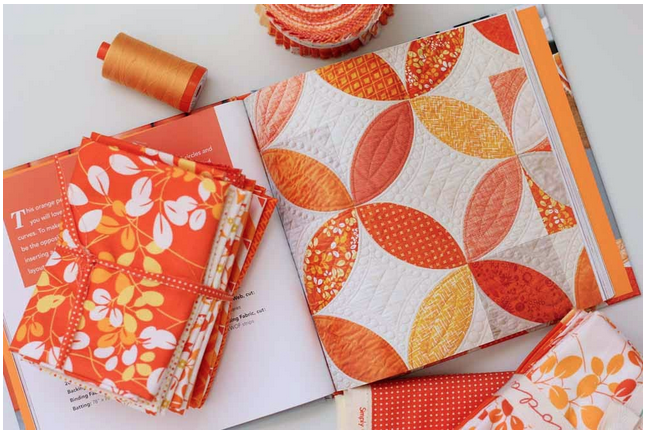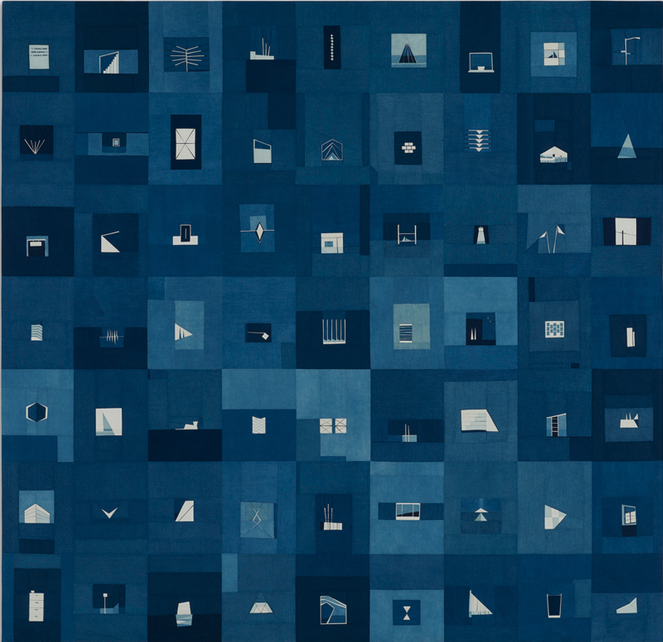 7
7

Simply Color: Orange by Vanessa Christenson. Image courtesy of V and Co.com.
As we continue our study of color, we begin with Monochromatic: the first of Five Color Plans found in nature. Monochromatic literally means 'containing or using only on color.' The Monochromatic color plan creates a sense of simplicity, calm, harmony and relaxation. It can also read as very sophisticated. Considered the most difficult of the five plans, understanding and working in a Monochromatic color family takes discipline and real focus. Let's say that you love the color orange and want to make a quilt in this color plan. Staying within the orange range means that no other color or neighboring color such as yellow-orange or orange-red may be used in your quilt.
On the surface this might sound simple, because you have a huge fabric stash, and orange is one of the largest collections within your stash. But, when you look at the Essential Color Wheel (below) it quickly becomes evident why most quilters avoid this plan. Do you notice how few options there are for using just orange in the wedge? Not so easy now, is it?
The trick to keeping a quilt from becoming visually flat is to use as WIDE a range of Tints, Tones, Shades and pure Orange as possible. Hand-dyed fabrics, with their subtle nuances, offer the quilter the widest range when it comes to working in a monochromatic plan. The old addage, "If five fabrics are good, then ten are even better", is a good thing to remember when building a fabric grouping.




To keep your quilts from looking flat or boring, let the Ultimate 3-in-1 Color Tool do the work for you when culling fabric from your stash or at a quilt shop. Each of the twenty-four pages features not only the pure color, but also the tints, shades and tones of that pure family. So all you need to do is hold the card up to the fabric you are considering to determine if it fits within your monochromatic plan. Think in terms of quantity.

Blue Blade by Grace Errea (Show 1303: Discover the Rewards of "Value-Based" Quilting)
Easy Monochromatic color plan tips:
-
Use a wide range of tones, tints and shades included with the focus color to keep the overall impression from appearing boring.
-
Hand dyed fabrics give you the most range within a color family.
-
Add visual interest with a variety of textured prints (dots, stripes, swirls, organic shapes, etc.).
Let's look at a number of excellent monochromatic color plan examples:


Wish Upon A Star by Cindy Needham. (Show 202 & Show 1606). Quilted Elegance by Rami Kim (Show 607).


The Value of Violet by Margaret Solomon Gunn. (Image TheQuiltShow.com) Prairie Silk by Agnes Stadler, Ann Stadler, Ann Solinski, Debbie Wanzer, Elizabeth Richards, Katie Cox. (Image from QuiltCon.com)


Sunny Disposition (Image courtesy of Laurie Ceesay). Honeycomb (Image courtesy of Kelly D. Young).


In The Act by Elaine Quehl. Crop Circles by Debbie Jeske (Image courtesy of Debbie Jeske).

Shape Study 26 by Erin Wilson. (Image courtesy of Erin Wilson)

Plus Mob by Valori Wells (Show 405 & Show 2605) [Image courtesy of Valori Wells].


Homage by Debbie Jeske with Bee Sewcial (Image courtesy of Debbie Jeske). Romancing Red by Michelle Jackson (Show 1002).
Practice Exercises:

-
Pull fabric from your stash to create one Monochromatic color plan, as in the example by Grace Errea above.
-
Using your collected fabrics, build any one (or both) of the blocks provided. To keep the focus on the monochromatic plan, simply paste the fabric pieces onto your worksheet.


Click here to download Monochromatic Exercise Block One .pdf file.
Click here to download Monochromatic Exercise Block Two .pdf file.
Click here for more topics related to The Art of Quilt Design program.















































.jpg)


